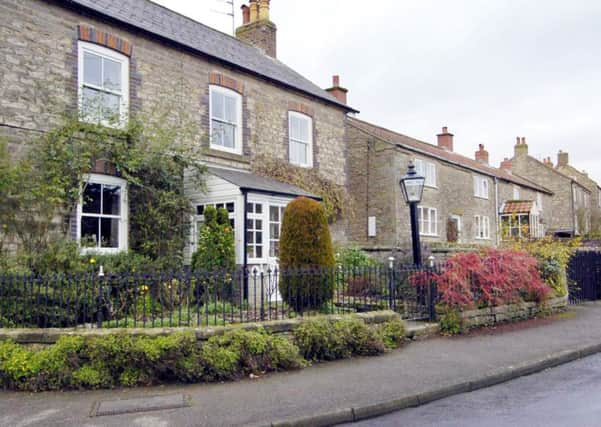Your Day Out: Plenty to do in Cropton


Access to Cropton is along the A170 Pickering to Kirkbymoorside road as far as a turn off to Wrelton, signed ¼ mile into the village. Take the main street by The Huntsman guest house and fork right up Cawthorne Lane. The single track lane winds into East Cawthorne.
Reaching the road junction, turn left along High Lane – part of the Tabular Hills Walk, flanked by wide, grassed verges and trees. The lane makes a right-angled bend and descends into Cropton.
Advertisement
Hide AdAdvertisement
Hide AdAt the south-west end of the village is a triangular green at the junction of roads to Wrelton, Rosedale and Newton-on-Rawcliffe. It is dominated by a handsome horsechestnut tree. Halt here to admire the superb view towards moors west of Rosedale. How about a photo? A flask of coffee may be welcome too.
Cropton is a pleasant village on limestone upland at the edge of Pickering moors. It has one wide, trim street that was once partly common grazing. There’s an unpaved back lane to the east, and a by road.
You’ll see the houses are mainly stone-built with red pantiles. Many were rebuilt from previous cruck houses and long houses from the 18th and 19th centuries. How many farm houses can you see? Notice the long gardens with crofts to the rear.
Shops gave way to travelling vans delivering bread, milk, fish and meat. Chat to the locals regarding facilities nowadays, as they no longer have a shop/post office. A garden to our left on Main Street had a notice on the wall, ‘Free to a good home’. Apples – beautiful cookers. What a kind gesture!
Advertisement
Hide AdAdvertisement
Hide AdBeyond, seek a sign: ‘Arts and Crafts Studio’. Feel free to browse, as it’s well worth visiting. Rosedale Lodge is opposite the post box, and the next door is the old chapel, now converted and overlooking the Reading Room dated 1898. Nearby is Rose Cottage dated 1695. Morleys Terrace is to the left, dated 1877 with a seat nearby.
Turn left to the Church of St Gregory, west of the main street. It’s a walled church in Norman style, perched on a hillock. This Victorian building is on the site of an earlier church. A pair of yew trees grow by the churchyard gate as you enter, and walk up to the door on the south side.
Entering, you’ll find a 12th century font – a tub font believed to have been shaped by the Normans. Adorning the lid was a colourful display of fresh autumn fruits and vegetables.
In the chancel you’ll admire two fine brass candelabra. Along with stained glass windows, you’ll also notice a lovely tapestry of St Gregory 540-604.
Advertisement
Hide AdAdvertisement
Hide AdLeaving the church door, directly ahead where once stood the village stocks in the churchyard, you’ll see part of an ancient cross. You may know the rhyme: “On Cropton cross there is a cup, and in the cup there is a sup.” The cup used to be placed on the cross and filled with water for thirsty travellers.
Behind the church, to the west of the churchyard, lie the mound and ditch marking the site of a Norman castle. It was built about the close of the 11th century by Robert de Stuteville. What a fine site overlooking Rosedale. Bumps in the same field reveal the structure of a Tudor Hall that was later demolished. The tradition of Easter egg rolling on the steep mound must have been a great sight. Is it still upheld?
Pre-historic barrows lie within the parish, and Roman Camps are worth viewing at East Cawthorne when time permits.
Returning to the main street, turn right to retrace your steps to the far end, and you may like to fork left along a back street signed, ‘Unsuitable for HGVs’. It gives more insight into the farms, crofts and solitude of this village.
Advertisement
Hide AdAdvertisement
Hide AdNow it’s back to the triangular village green, and bearing left takes you to the bottom of the village where stands the New Inn.
There used to be three ale houses in Cropton. This pub brews its own beer and is well known to real ale enthusiasts.
To the south of the village are deep hollows at the side of the roads. These are the remains of disused limestone quarries for which Cropton was noted. For centuries limestone was kiln-burned and carried north over the moors for agricultural use.
l [Of additional interest is that in the village were born the famous William Scoresbys – father and son. The father was born on a farm and became navigator of the Arctic. He stood nearer the pole than any before him on May 25, 1806.
Advertisement
Hide AdAdvertisement
Hide AdHis son developed rather more as a scientist than explorer. He invented an apparatus that revealed the temperature of the Arctic Ocean bed, and wrote the best work on the Arctic until them. Deeply religious, he gave up the sea and entered the church, sacrificing £800 a year for a poor curacy.]
Distance of walk, drive, or cycle ride approximately six miles; village walk alone, only about a mile.
Refreshment: The new Inn, Cropton, or take a picnic.
Transport: 128 bus as far as Wrelton turn-off.